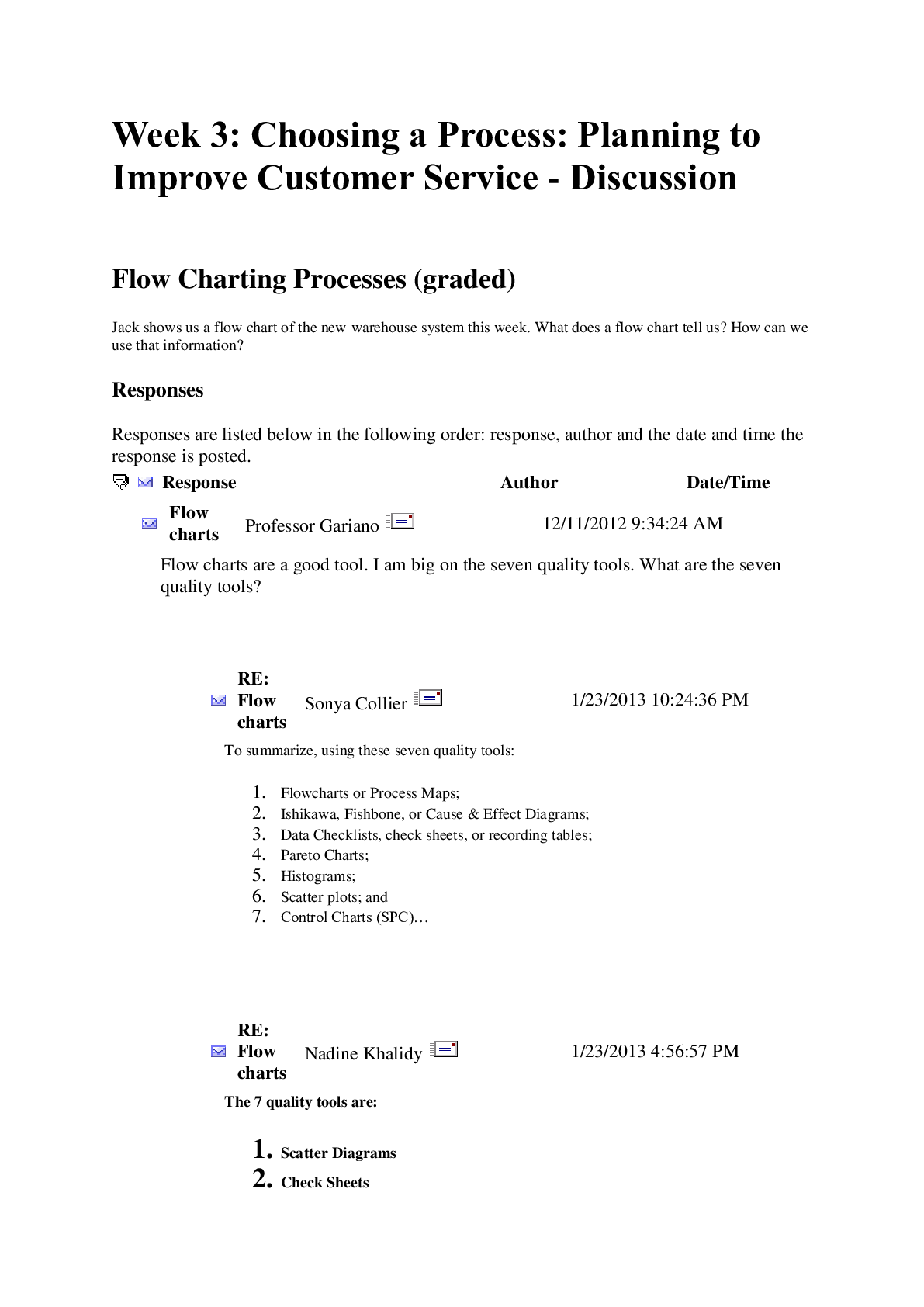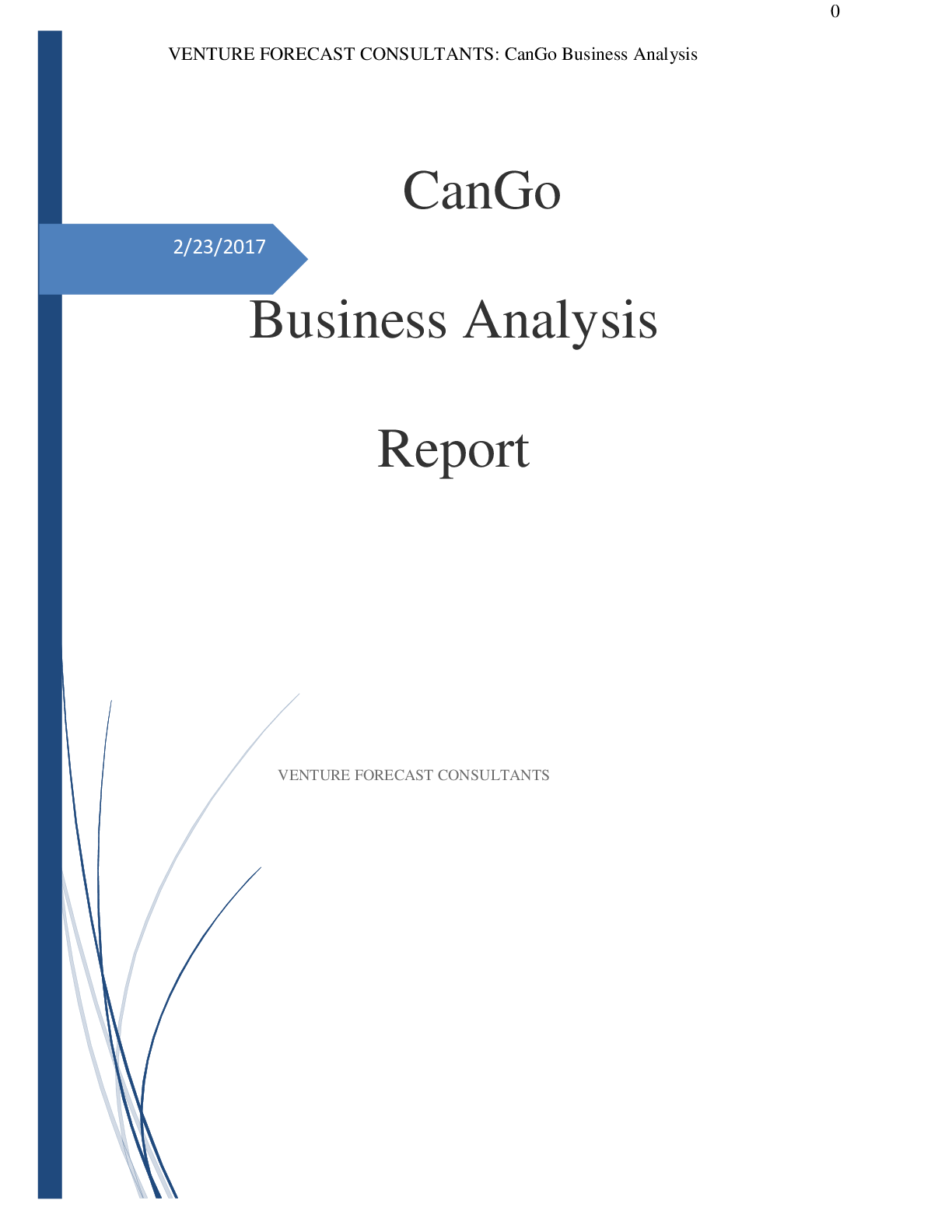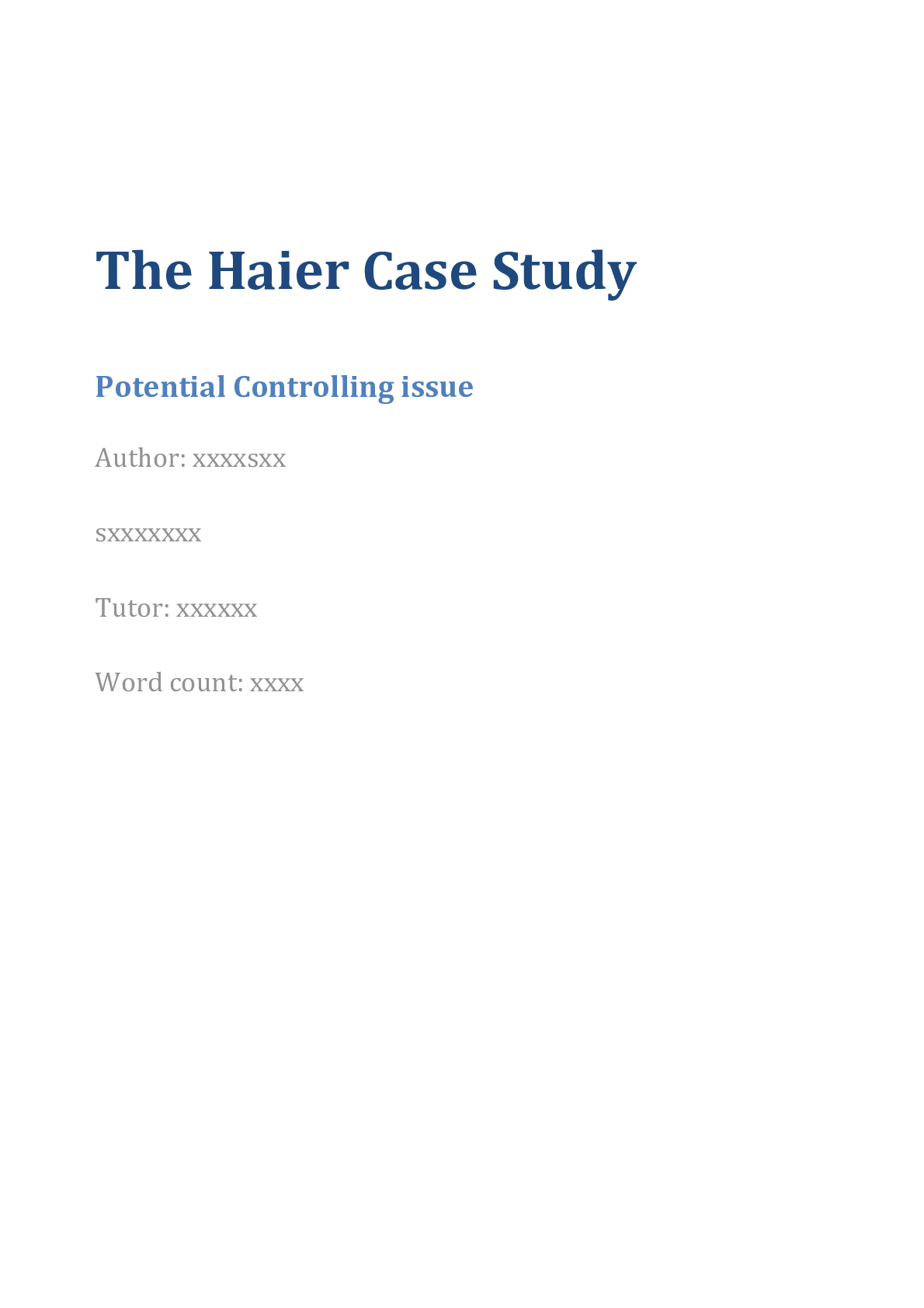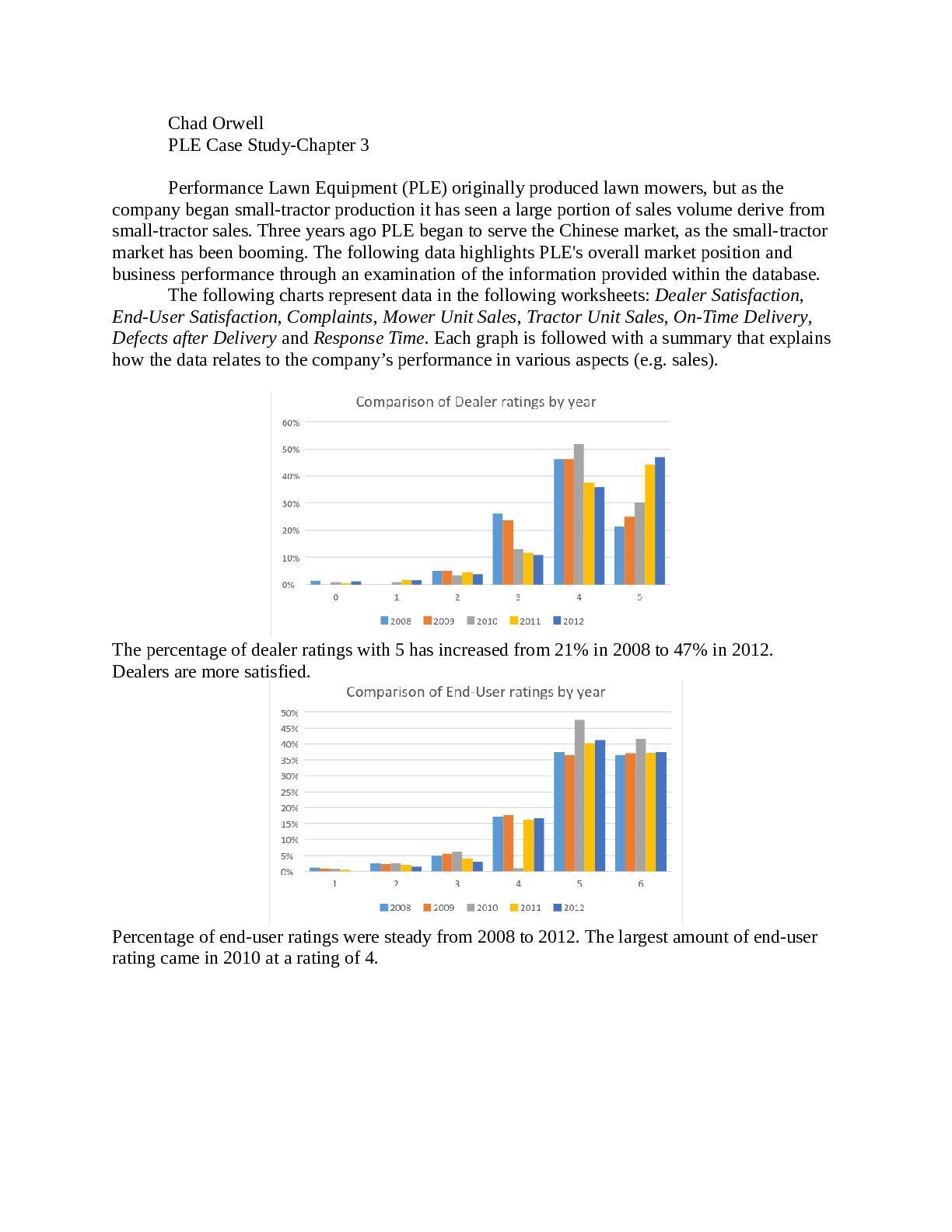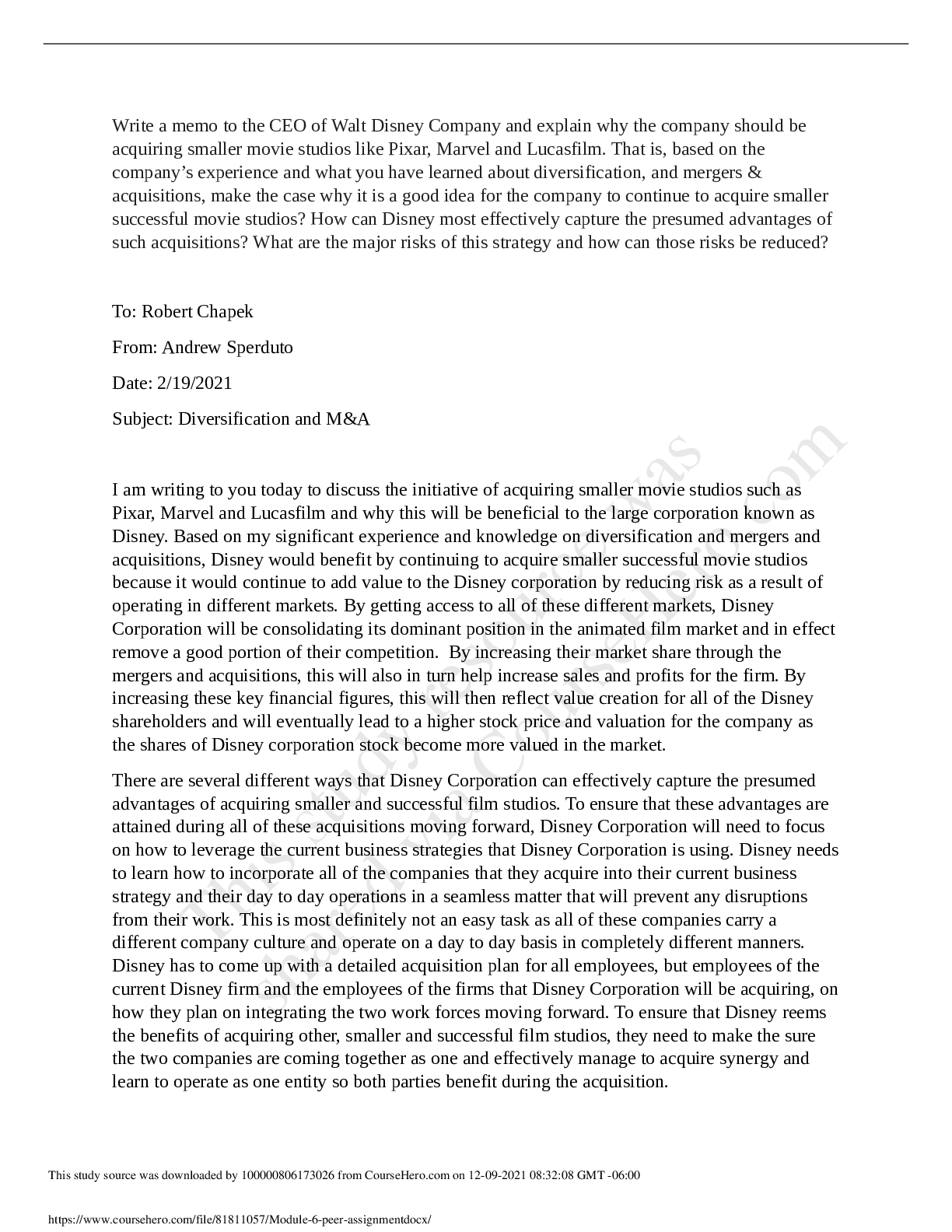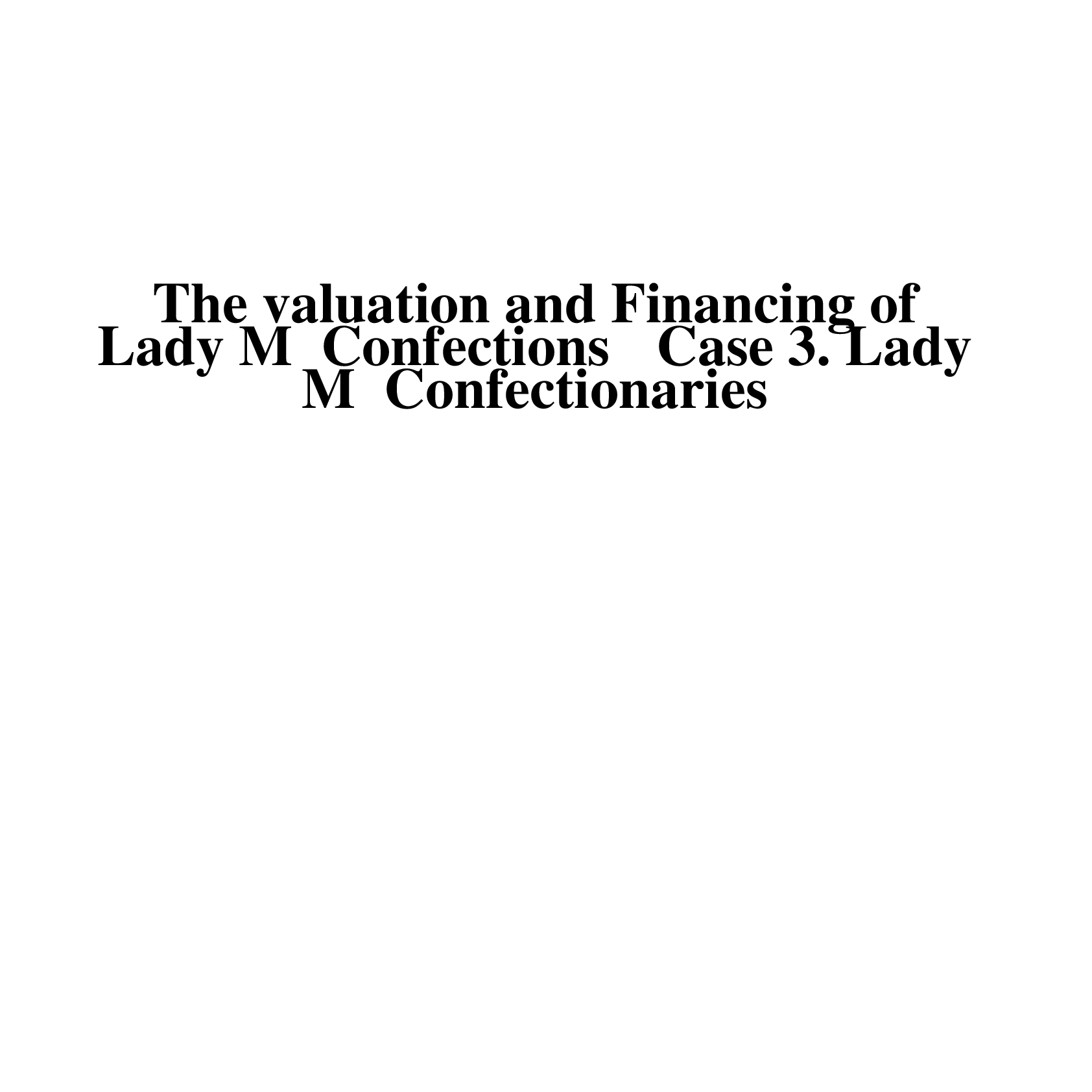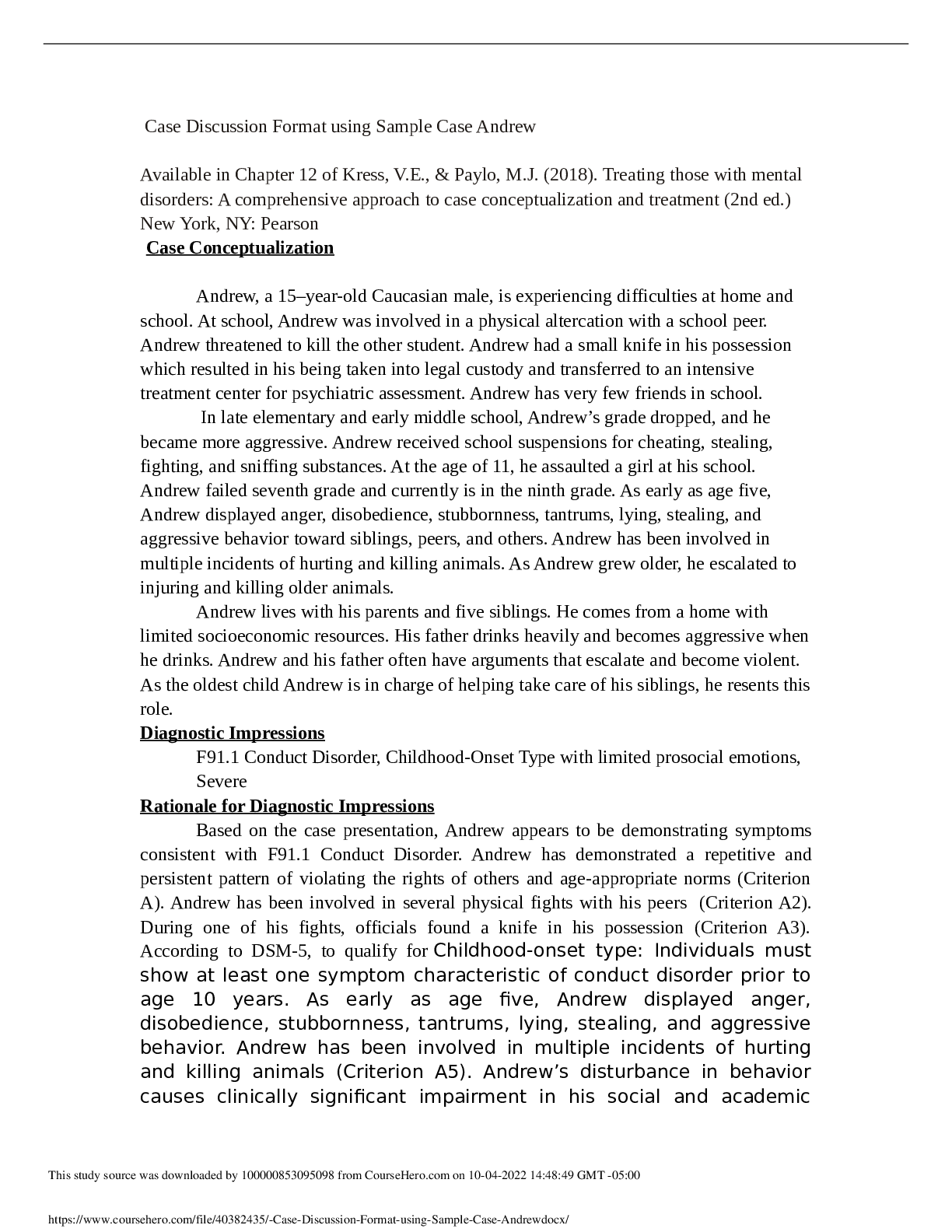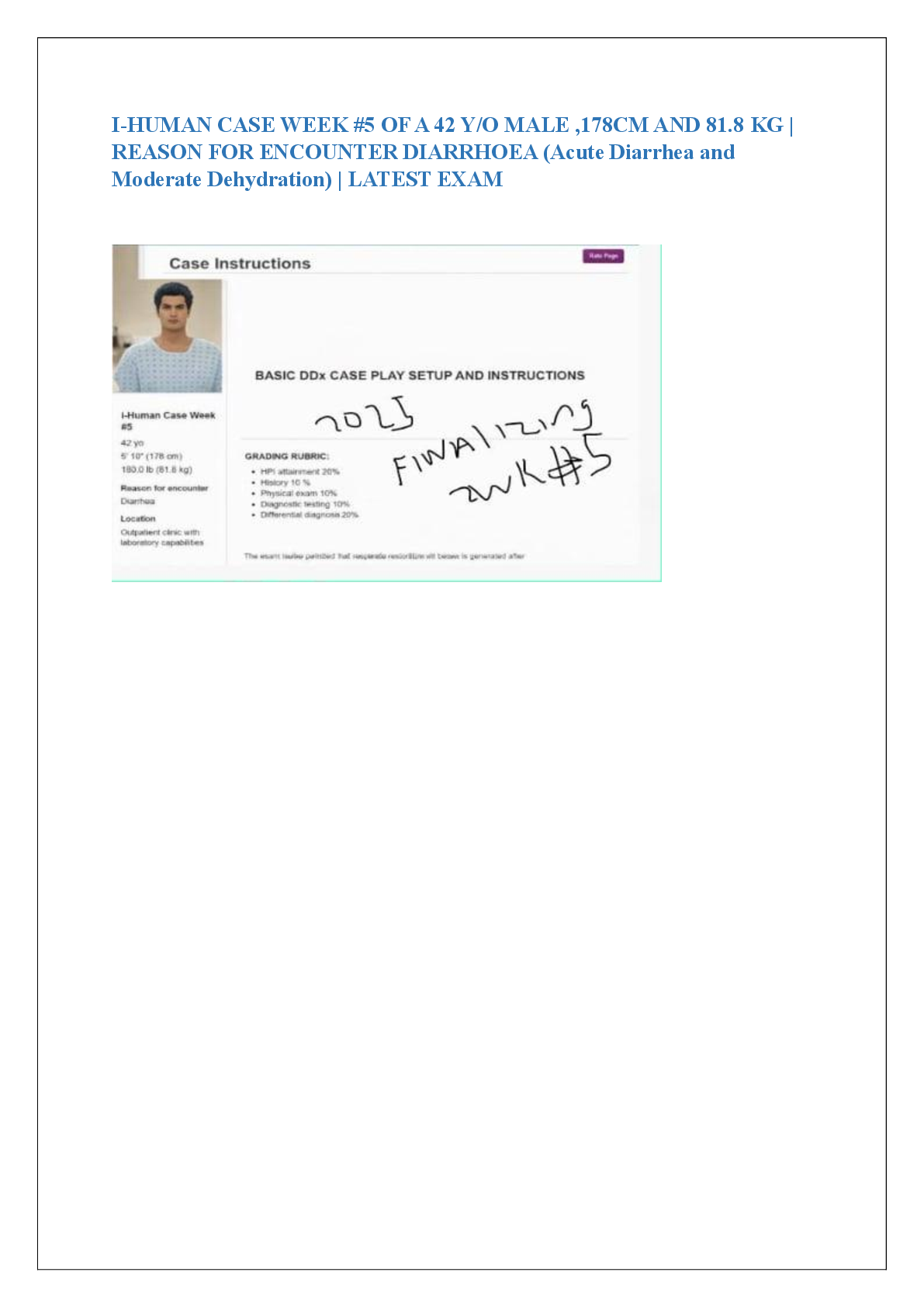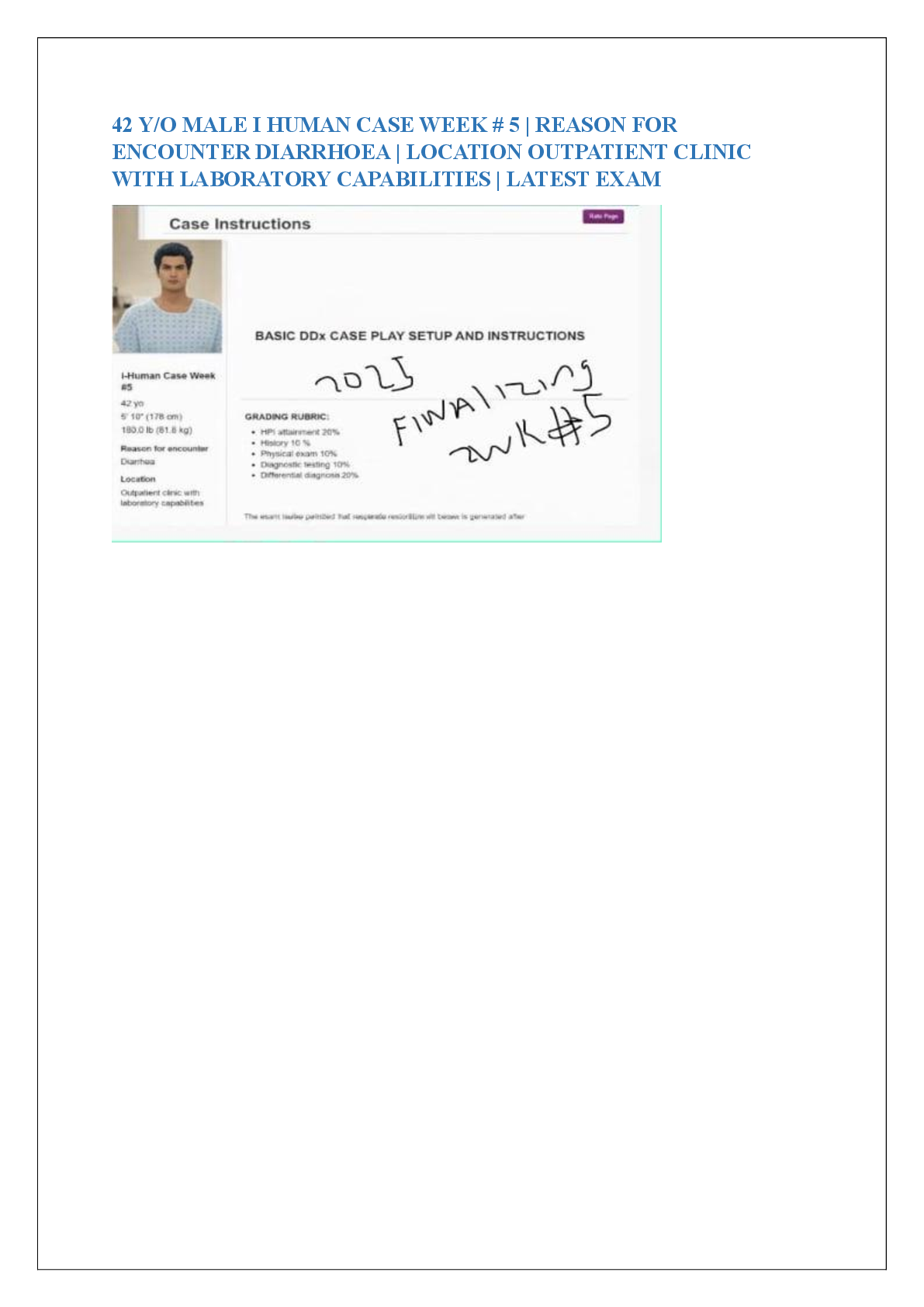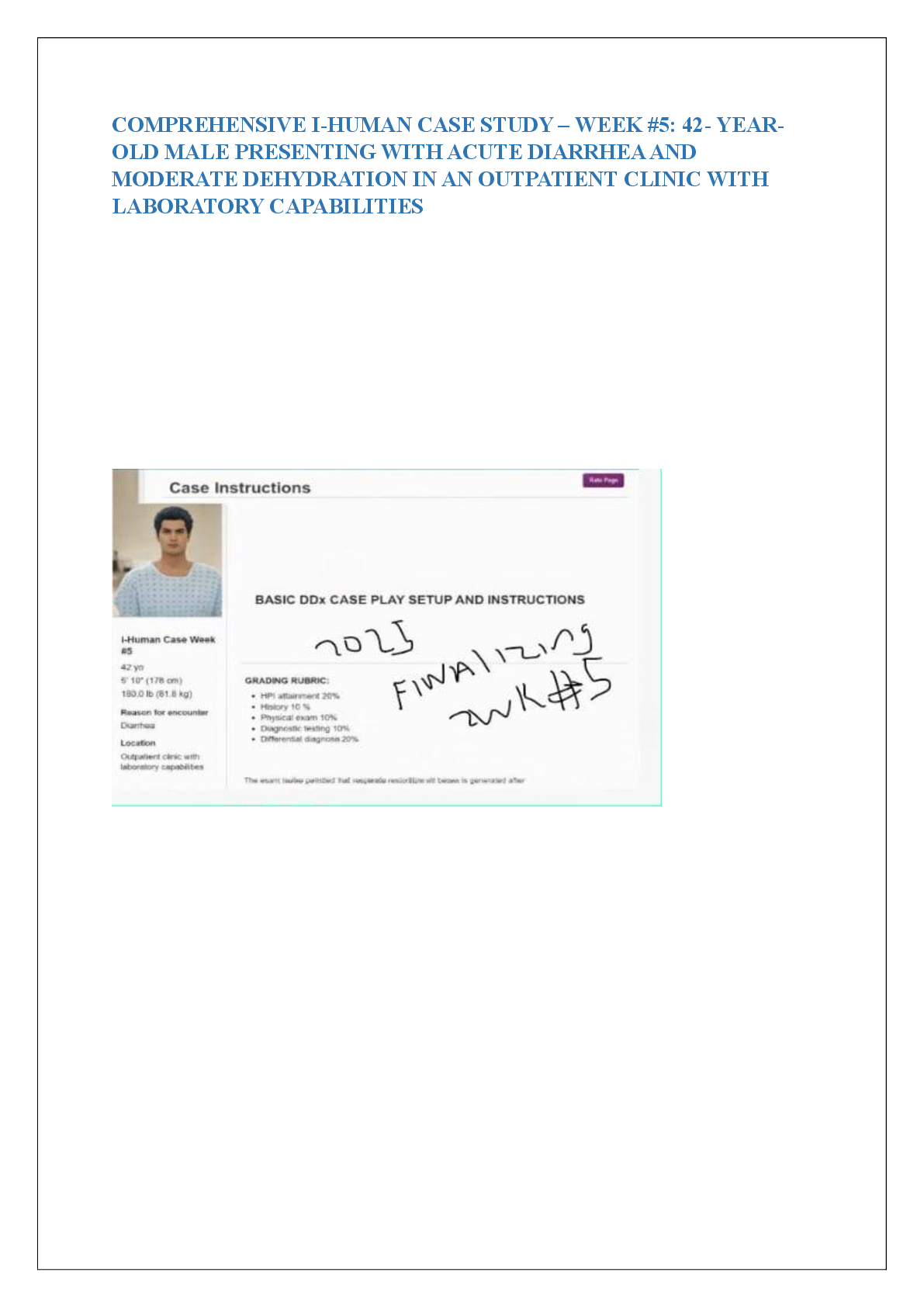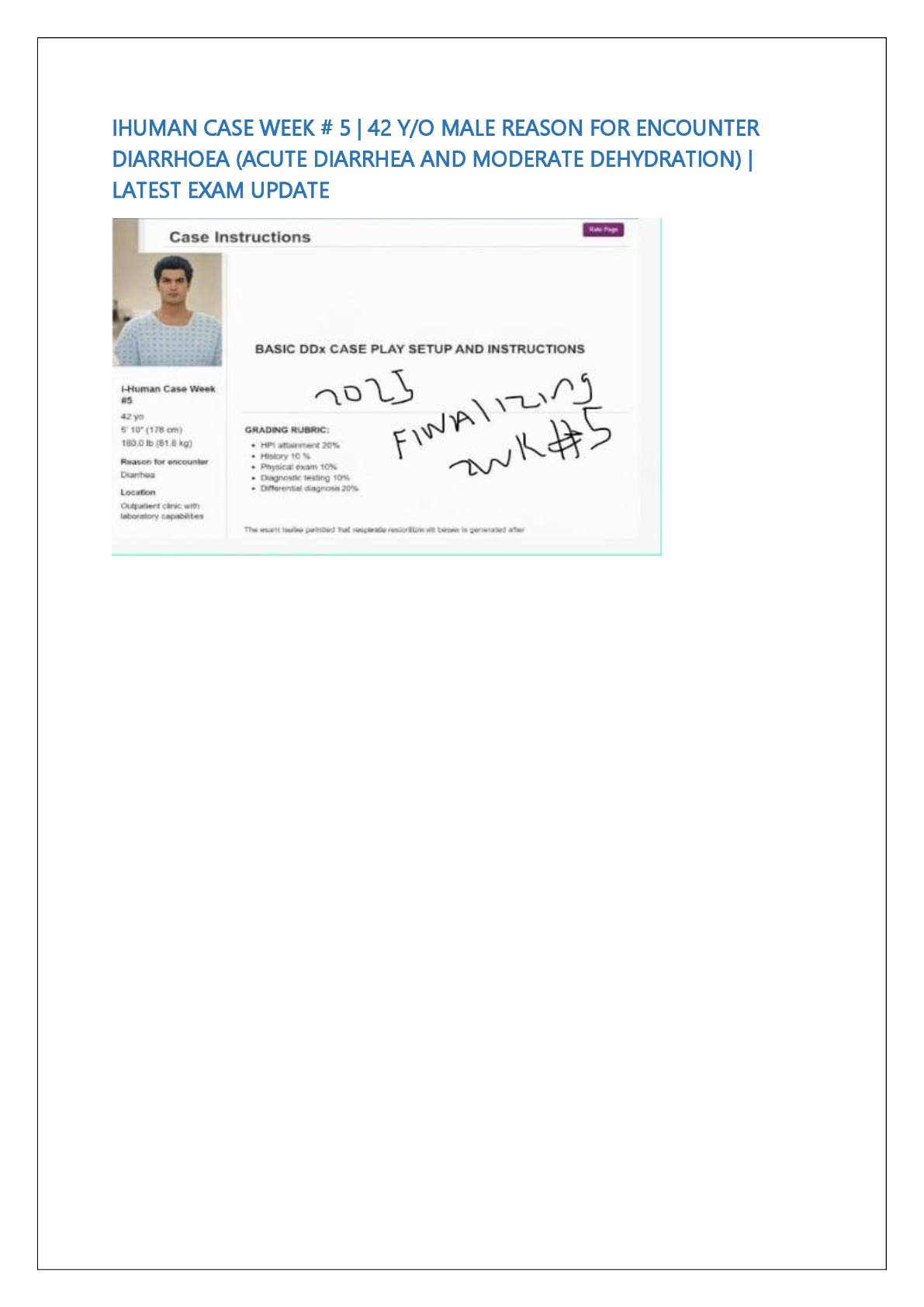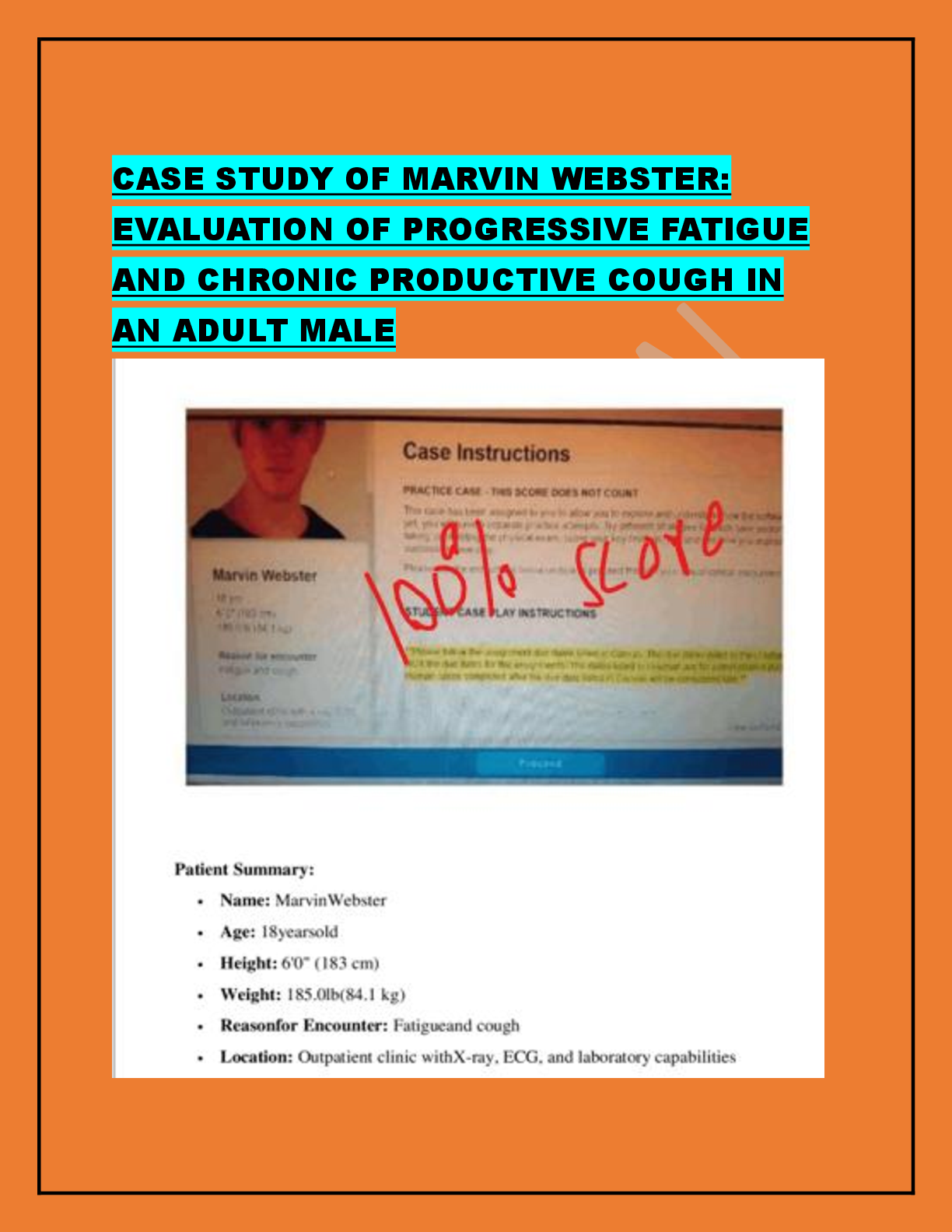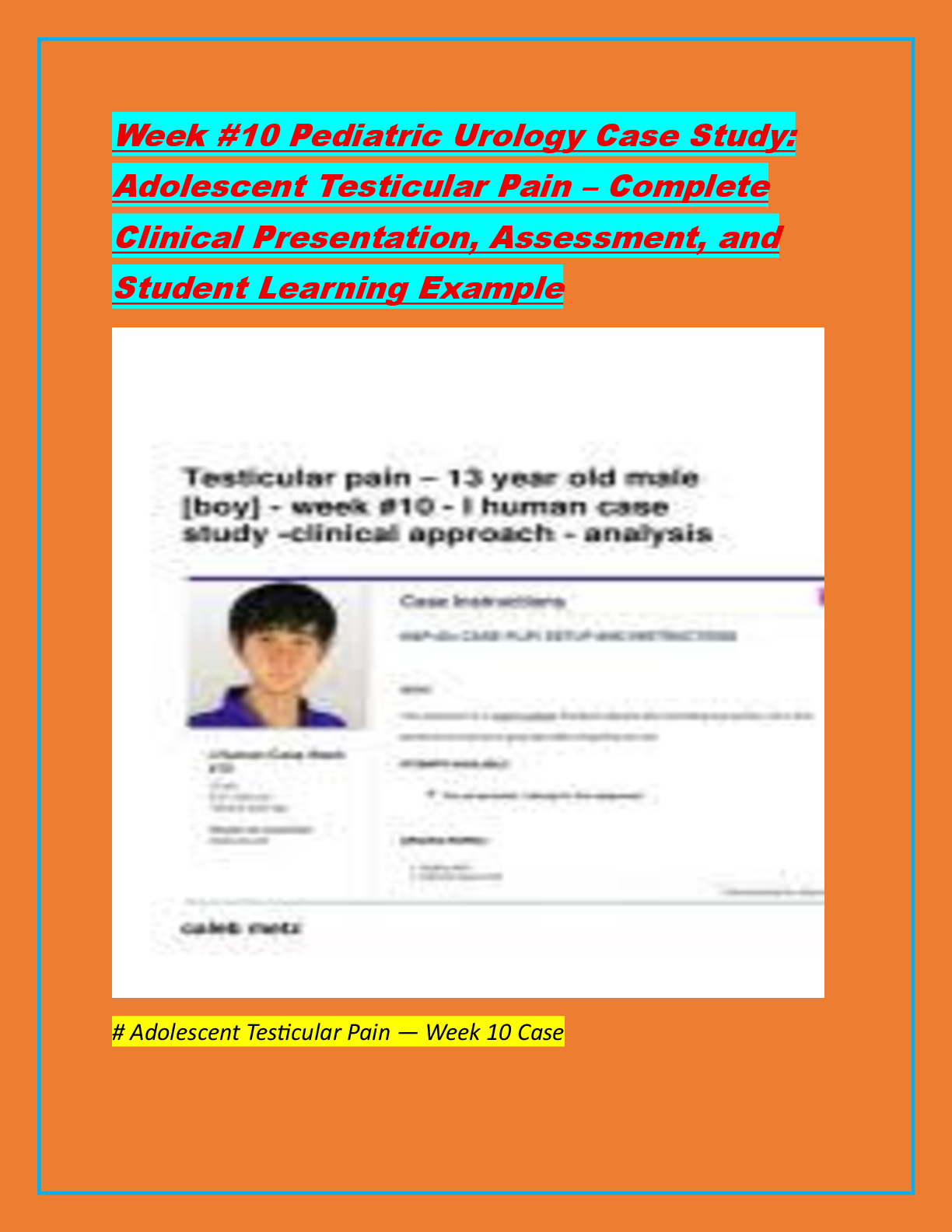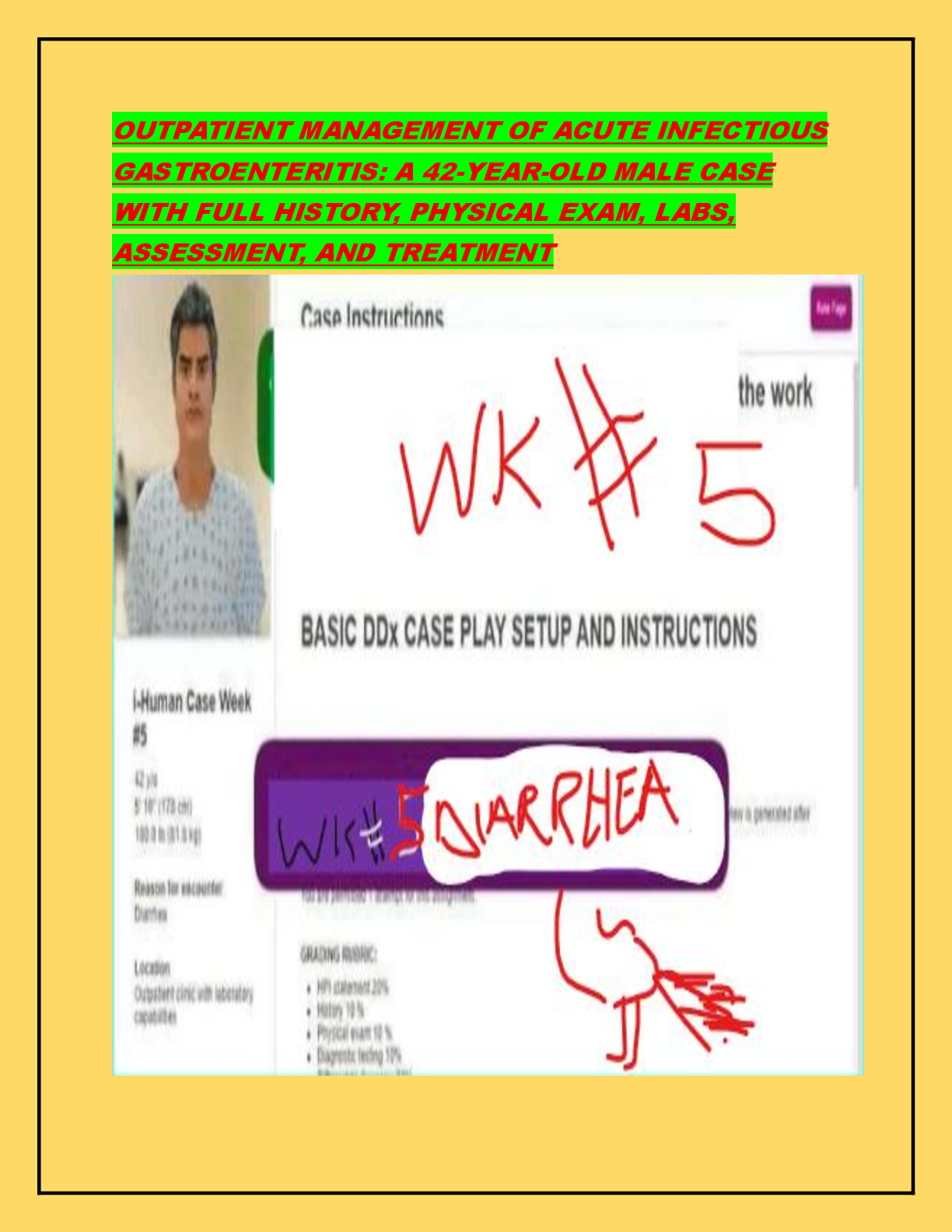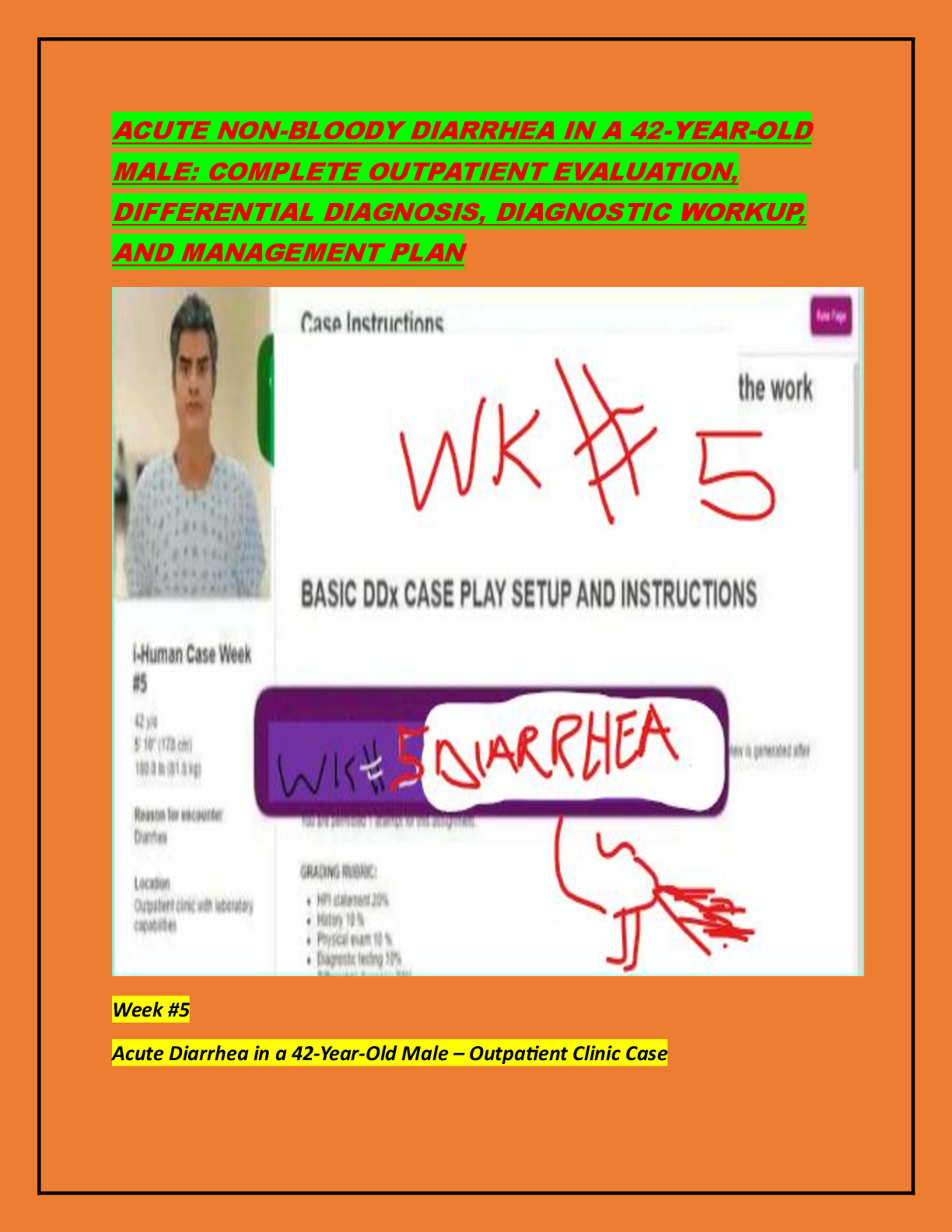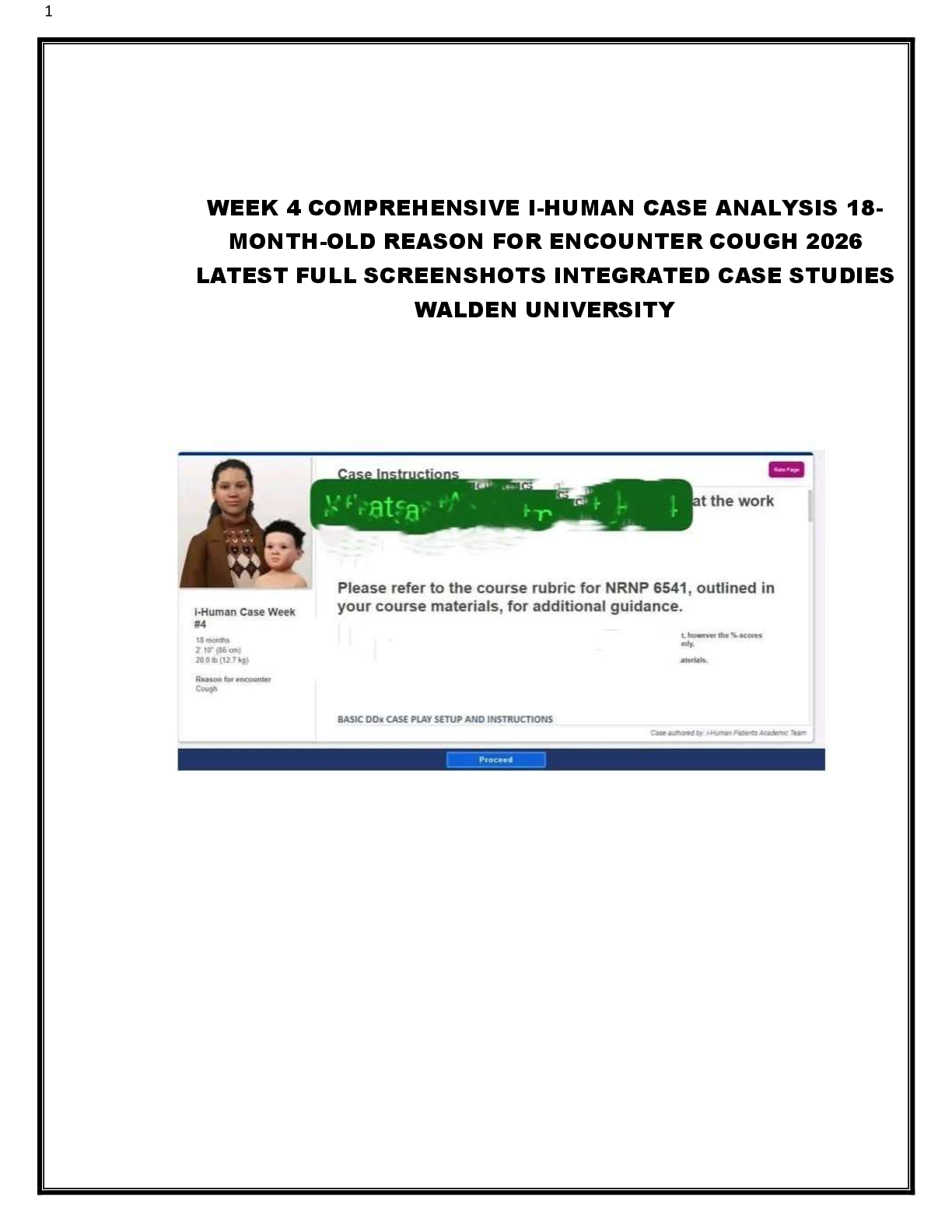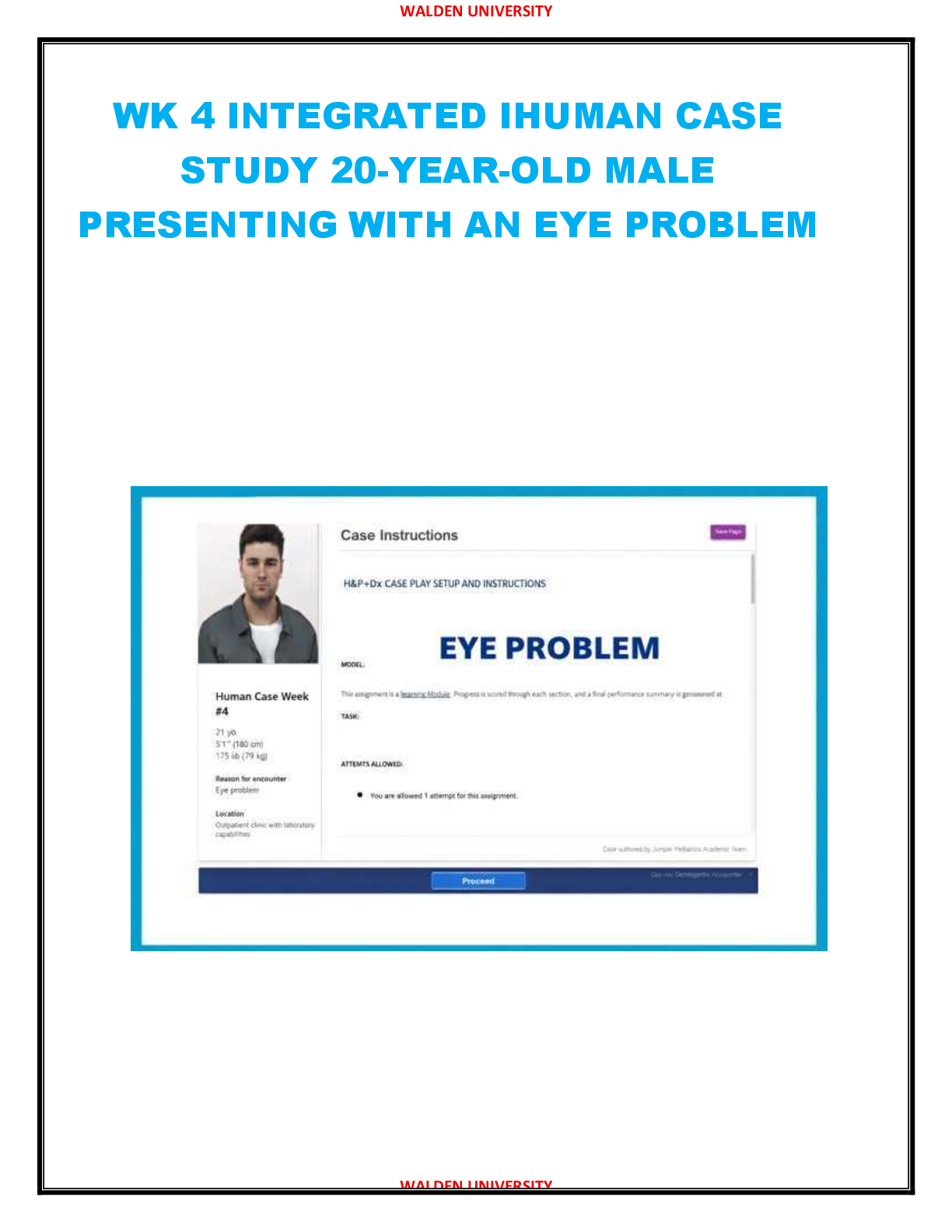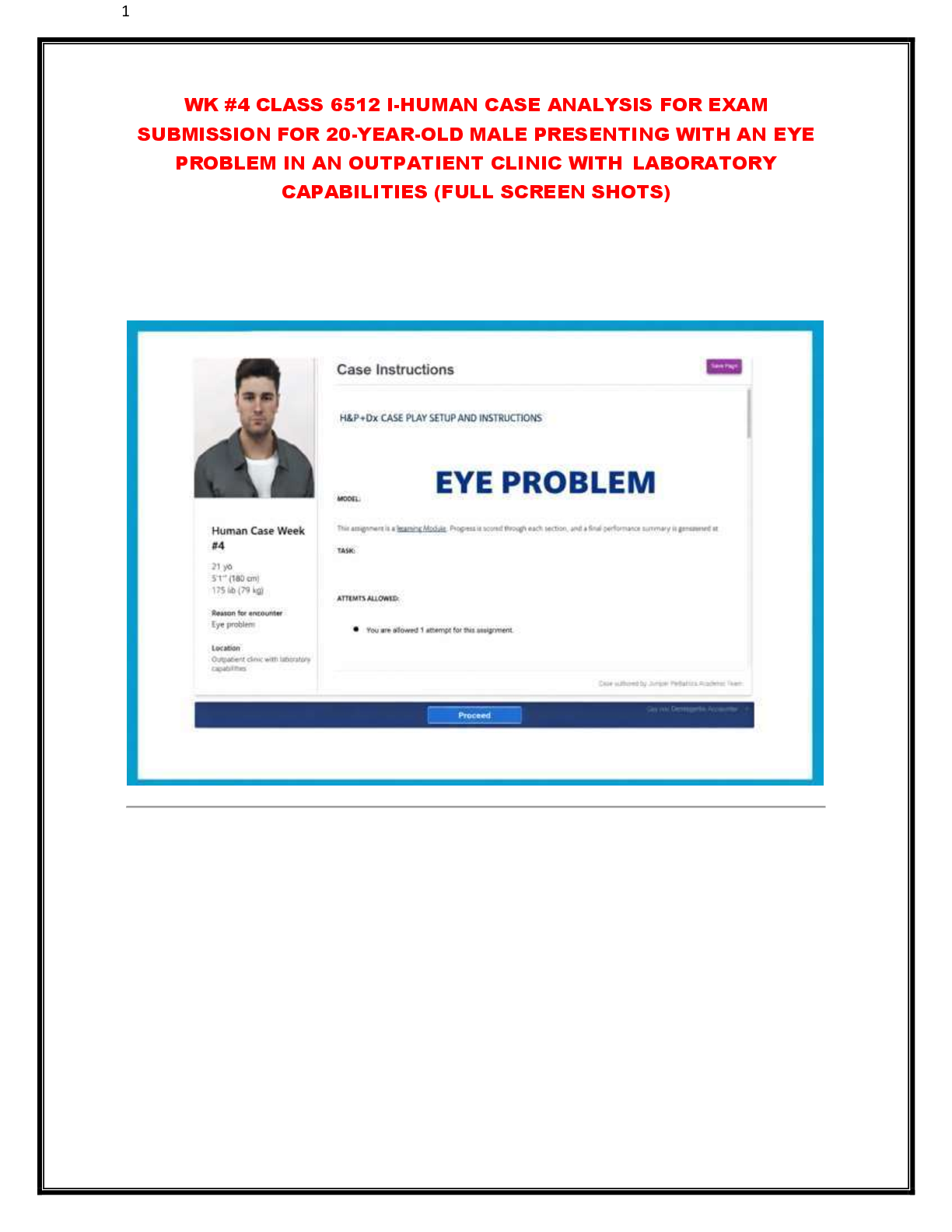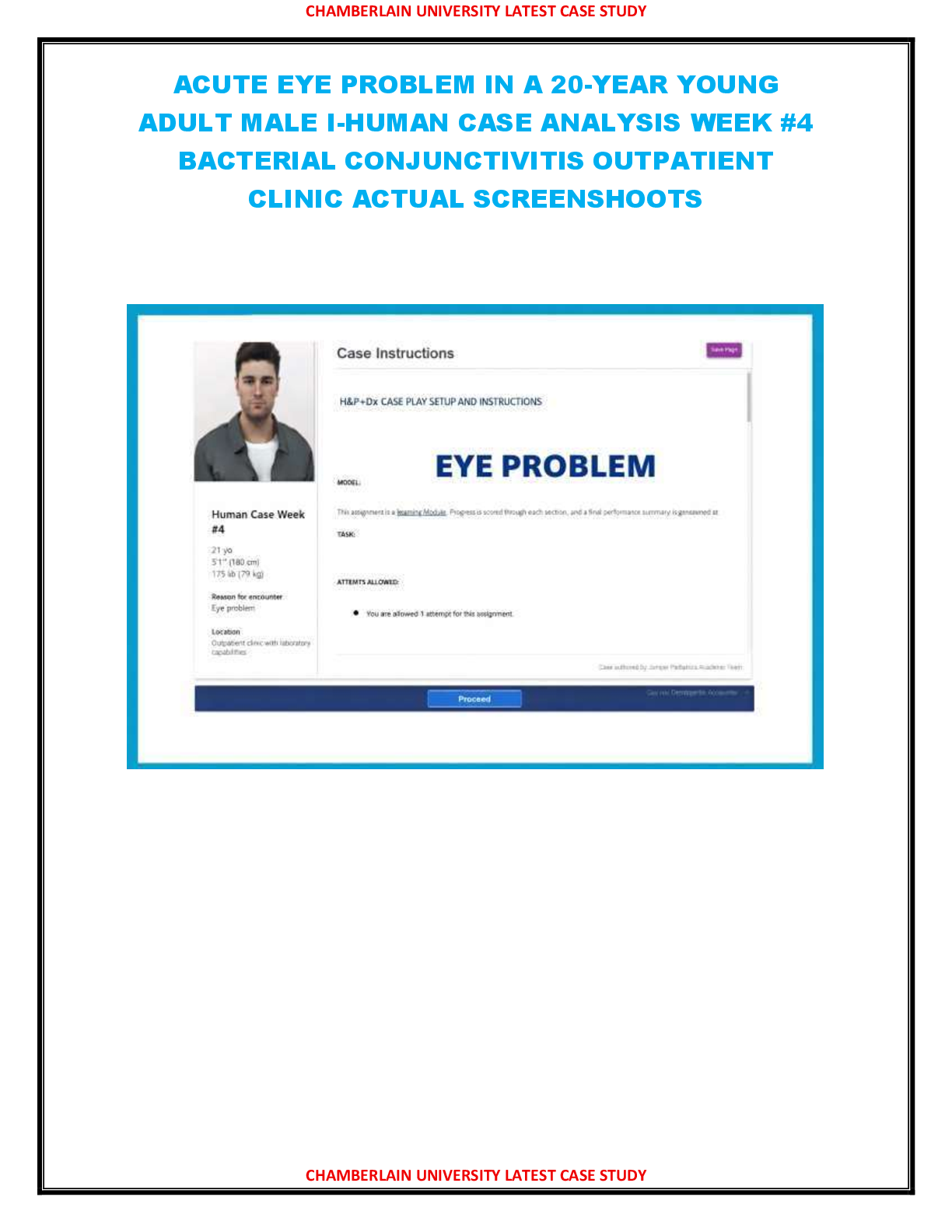*NURSING > CASE STUDY > Patho Exam 1 Review. All Answered (All)
Patho Exam 1 Review. All Answered
Document Content and Description Below
Patho Exam 1 Review 1. Two thirds of the body’s water is found in its: a. Interstitial fluid spaces b. Vascular system c. Intracellular fluid compartments d. Intraocular fluids 2. In add ... ition to osmotic pressure, what force is involved in the movement of water between the plasma and interstitial fluid spaces? A. oncotic filtration B. buffering pressure C. hyponatremic pressure D. hydrostatic pressure Hydrostatic pressure is the pushing force. Physical pushing of your blood pressure. Osmotic pressure is the pull force. It pulls from an area of low concentration to an area of high concentration. 3. Low plasma albumin causes edema as a result of a reduction in which pressure? a. Capillary hydrostatic b. Interstitial hydrostatic c. Plasma osmotic d. Interstitial osmotic 4. Dehydration can cause which result? SATA a. Moist mucous membranes b. Weak pulses c. Tachycardia d. Polyuria e. Weight loss , because It causes less fluid volume – blood pressure decreases/heart rate increases. When blood pressure decreases, it can’t push against pulse points to feel any pulses. C. when low blood pressure occurs, heart rate has to be faster because the body isn’t getting adequate amounts of oxygen and blood to the body making the heart work harder. This creates a faster heart rate. E. because you are holding onto water weight. 5. A patient’s blood gasses reveal the following findings: pH 7.3, bicarbonate (HCO3) 26 mEq/L CO2, and 58 mm HG. What is the interpretation of these gases? a. Respiratory alkalosis b. Metabolic acidosis c. Respiratory acidosis d. Metabolic alkalosis 6. A patient’s blood gases reveal the following findings: pH 7.45, HCO3 28 mEq/L, CO2 43 mm Hg. What is the interpretation of these gases? a. Respiratory alkalosis b. Metabolic acidosis c. Respiratory acidosis d. Metabolic alkalosis 7. When a child inherits a disease that is autosomal recessive: it is inherited from: a. Father b. Mother c. Grandparents d. Both parents 8. An x-linked recessive disease can skip generations because: a. Females are heterozygous for the x chromosome b. The disease can be transmitted through female carriers c. Mothers cannot pass x-linked genes to their sons d. These diseases need only one copy of the gene in females 9. An individual’s genetic makeup is referred to as his or her: a. Phenotype b. Genotype c. Heterozygous locus d. Homozygous locus 10. The parents of a baby with down syndrome are seeking genetic counseling, the baby has been identified as having trisomy of chromosome 21. The nurse would include which information when counseling the clients about the risk of conceiving another child with trisomy 21? a. The risk increases with maternal age b. There is no risk of a second child with down syndrome c. The parents will almost certainly have a second child with down syndrome d. The age of the father is a bigger risk factor than the mothers age 11. What process causes heat and redness to occur during the inflammatory process? a. Vasodilation of blood vessels b. Platelet aggregation c. Decreased capillary permeability d. Endothelial cell contraction 12. Which manifestation of inflammation is systemic? a. Formation of exudates b. Fever and leukocytosis c. Redness and heat d. Pain and edema 13. What is the final stage of the infectious process? a. Colonization b. Invasion c. Multiplication d. Spread 14. The function of the tumor cell marker is to: a. Provide a definitive diagnosis of cancer b. Treat certain types of cancer c. Predict where cancers will develop d. Screen individuals at high risk for cancer Example: things like hormones, antibodies etc. that are produced by cancer cells. These things can be present without the cancer being there and alert to look further into it. These substances can only help with screening, they cannot treat or provide anything. 15. It has been determined that a tumor is in stage 2. What is the meaning of this finding? a. Cancer is confined to the organ of origin b. Cancer has spread to regional structures c. Cancer is locally invasive d. Cancer has spread to distant sites A = stage 1 (Rachel by herself) C = stage 2 (Rachel and a classmate) B = stage 3 Rachel walking across the room with classmate D = stage 4 (metastasis = moving from one area of the body to another area of the body) Rachel and entire class walking down the hallway 16. Which statement is true regarding pain and cancer? a. Pain in primarily a result of pressure caused by the tumor b. Pain indicates the metastasis of a cancer c. Pain is usually the initial symptom of cancer d. Pain is generally associated with late stage cancer 17. What are the most common causes of nosocomial infections among patients with cancer? SATA a. Indwelling medical devices b. Suppressed immune system c. Visitor introduced microorganisms d. Poor appetite e. Inadequate wound care , C, E (nosocomial = healthcare acquired germs//indwelling = something that is inside and outside of you ((catheter/IV’s))) Suppressed immune system wouldn’t be correct because it is not a direct nosocomial cause/effect relationship. Seeding = refers to the spread of cancer cells in body fluids or along membranes, usually in body cavities. Seeding can be spread by removal of cancer with a scalpel. ^^^ Think of gardening and removing dandelions; the fuzzies will spread and seed will fall in the grass. From the grass, new dandelions will grow and multiply. The same thing occurs with cancer cells during the removal process. Cancer microbes will be present on the scalpel scratching ‘fresh skin’ thus, infecting it and spreading. Seeding and metastasis are NOT the same. Hydrostatic pressure = High concentration to low concentration Osmotic pressure = other one (low concentration to high concentration) Autosomal = chromosomes Carrier = they don’t have the disease, but it’s in their DNA – so they are a carrier. It is ‘tucked away’. 1. Patient S.B is a 29-year-old female who came to the ER with c/o panic attack and palpitation. Vitals are BP 145/95, HR 113(high), RR 32, Temp 98.6. The patient's friend states that she just found out that her mom passed away. What should the nurse prepare to treat the patient for? 2. What is the cause of edema? Patient has swelling of the ankles that often happens at the end of the day or after prolonged standing: 3. Patient Albert Smith, 45-year-old male came to the ER with complaints of muscle weakness, fatigue, and a racing heartbeat. Patient vital signs are, BP 110/65, HR 120, RR 20, Temp 98.6. Labs are NA+ 140 (normal), K+ 2.5 (low), Mg 2.0(high). Which complication should the nurse be more concerned with? a. palpitations b. nausea & Vomiting c. cardiac dysrhythmias d. muscle weakness that progress to paralysis 3. What is the cause of edema? Patient has the abdominal swelling that occurs with starvation: a. reducing plasma osmotic pressure b. Obstruction of lymphatic circulation c. Increased capillary hydrostatic pressure d. Increased capillary permeability, as in inflammation 4. The sequence of inflammation events within the blood vessel is: (2.5 points) a. slower blood flow, vasoconstriction, increase permeability, edema b. vasodilation, increased capillary permeability, plasma leakage, edema c. vasoconstriction, decrease blood flow to injury site, edema 5. The first line of defense of the body is: 6. What is the cause of edema? Patient has history of arthritis=(inflammation of joints) and complaints about joint swelling: a. Obstruction of lymphatic circulation b. Increased capillary hydrostatic pressure c. Reducing plasma oncotic pressure d. Increased capillary permeability, as in inflammation* 7. What is the cause of edema? Patient has a swollen arm due to mastectomy(surgical removal of one or both breasts). Obstruction of lymphatic circulation* Increased capillary hydrostatic pressure Reducing plasma oncotic pressure Increased capillary permeability, as in inflammation ! 8-10. Match pathophysiologic abnormality with patient condition. (2.5 points) 23 years old female is diagnosed with lupus. B 13-month-old child reveals serious, recurrent bacterial and fungal infections. A 39-year-old patient c/o trouble breathing, hypotension, and urticaria after taking antibiotic. C 1. Immune deficiency 2. Autoimmunity 3. Hypersensitivity 11. Third line of defense includes: a. T and B lymphocyte, antibody* b. Skin, mucous membranes, gastric acid, microbiome-1st line c. Phagocyte and inflammatory response-2nd line 12. Patient J. W is a 55-year-old male who came to ER with c/o swelling of the legs, feeling tired and drowsiness. Patient has medical history of renal failure. Patient vitals are BP 175/95, HR 98, RR 18, Temp 98.4. What should the nurse prepare to treat the patient for? (2.5 points) a. metabolic acidosis* b. respiratory alkalosis c. metabolic alkalosis d. respiratory acidosis 13. A person with a history of chronic lung disease arrives in the clinic with a 1-week history of a productive cough. The nurse suspects the person is experiencing: (2.5 points) Respiratory acidosis* respiratory alkalosis. metabolic acidosis. metabolic alkalosis 14. M.C. is a 25-year-old male, who has a wet to dry dressing to the abdomen. While changing the dressing the nurse notices redness, swelling, and purulent drainage. M.C. vitals are BP 135/76, HR 92, RR 22, Temp. 101. Which assessment is not a systemic sign of infection? a. fatigue b. fever c. purulent exudate* (puss-due to more leukocytes)-->LOCAL SIGN d. nausea 15. B. J. is a 12-year-old boy who came to the ER with c/o pain and swelling to the right ankle due to falling while playing basketball. Vitals signs are BP 135/83, HR 74, RR 20, Temp: 98.6. Which physical assessment is not a local effect of inflammation? (2.5 points) a. redness b. pyrexia* c. edema (swelling) d. pain 16. Second line of defense of the body is: - Phagocytosis Inflammation/ non-specific Macrophages* 17. When the body produces antibodies against its own tissue, the condition is called? (2.5 points) A. hypersensitivity B. an antibody reaction C. a cell-mediated immunity D. an autoimmune disease 18. A person arrives in the emergency department after having a loss of consciousness. The individual has a history of diabetes and 2 days of diarrhea. The nurse suspects the person has: (2.5 points) respiratory alkalosis respiratory acidosis metabolic alkalosis metabolic acidosis **also known as Diabetic Ketoacidosis (DKA) 19. What is the cause of edema? Patient has the abdominal swelling that occurs with starvation: reduced plasma oncotic pressure **loss of proteins in the blood 20. Active immunity includes: (select all that apply) (2.5 points) Patient has a history of measles Patient has been vaccinated for chickenpox Patient has a history of chickenpox Patient received an immune globulin transfusion 1st line of defense: -nonspecific -mechanical barrier -unbroken skin and mucous membranes -secretions such as tears and gastric gases 2nd line of defense: -nonspecific -phagocytosis -inflammation 3rd line of defense: -specific -production of specific antibodies or cell-mediated immunity -immunizations [Show More]
Last updated: 3 years ago
Preview 1 out of 8 pages

Buy this document to get the full access instantly
Instant Download Access after purchase
Buy NowInstant download
We Accept:

Reviews( 0 )
$9.00
Can't find what you want? Try our AI powered Search
Document information
Connected school, study & course
About the document
Uploaded On
Mar 21, 2020
Number of pages
8
Written in
All
Additional information
This document has been written for:
Uploaded
Mar 21, 2020
Downloads
0
Views
169


